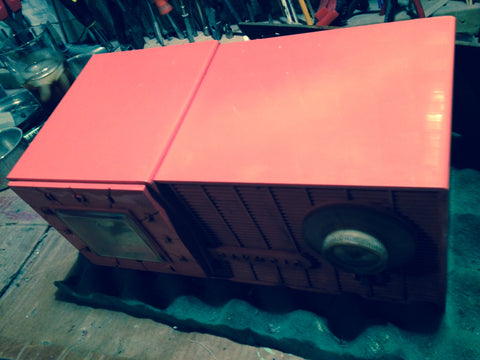Olympic Hot Pink retro Jetsons radio. Used by great-grandmother back in 50's and 60's
Here is a beautiful hot pink Olympic Model 408. According to the seller, it was used by his great-grandmother during the 50's and 60's. Cool.

No cracks on top. This is a rare model from a rare manufacturer. It possesses all the hallmarks of cool retro 50's styling. The offset protruding placement of the clock mechanism. The radial indented lines to denote clock hour numbering. And, the color is totally pimp. This is not a salmon, or pastel, or coral pink. It's in-your-face watermelon color pink. Like Jolly Rancher's Watermelon candy pink. Any bolder and it would be neon pink which I've never seen in a 50's tube radio. This is about the brightest pink I've come across.
The volume knob was shattered during shipping, but it's a simple reconstruction. The little clock knob was missing. Initially, I thought this would be straight forward replacement but I was wrong. More on this later.
The inside was all original and dusty and redolent of fabric softener, carpet musk, and animal dander. A retro radio potpourri of sorts.

No crack on top! Hooray! There's 50% of the value right there.

The sides of this radio still had some of its original gloss. The tuning knob had the usual white chalky build-up. Does anybody know what this is? My guess is repeated condensation and evaporation causes this accumulation of a chalky soap-like substance that doesn't wash off with water or soap. This stuff needs to be brushed or scoured off. I haven't found a solvent that dissolves this crud away without damaging the plastic underneath.
The clock face is original and in good condition. The clear plastic clock face is not cracked either. Another 10 -15 points on the value scale. No tarnish, pin pricks, or flaking on the metal clock face. Good.
When I plugged it in initially, all I heard what I thought was filter hum but I found out later on it wasn't. Here's what it sounded like when I first plugged it in. Turns out, the circuit board was partly cracked. The circuit trace lines were broken. The aluminum filter capacitor didn't need to be replaced at all. One .047uf wax and paper capacitor had to go. I reconstructed the broken trace lines by bridging with braided wire and soldering it down to the circuit board. I had to reconstruct about 6-7 of these connections. Then, I plugged it in and out blared Lars Larson's tirade about gun control, Obama, or ISIS, or immigration, etc. The audio quality was great. The audio content, on the other hand, made me want to solder my ears shut.
The power cord at the connect interchange was beginning to separate. The happens all the time. After years and years, the power cord begins to fatigue at the base of the connection to the backing board. the only solution is to bypass the base connector and solder the power cable directly to the circuit board pins. I usually tie a knot on the inside to prevent the cord from pulling out the circuit board pins if it's yanked too hard. The best solution is to replace the cord with an original cord that has a circuit board safety interchange connector but I haven't found these any where.
Here's what it looks like before I added the strengthening clip:

Here's with the strengthening clip:

Here's the insides all cleaned up and re-assembled:


Here's a YouTube video with radio playing. Sounds great!
Finding a little clock on/off/alarm knob turned out to be quite a pain, but in the end patience prevailed. Here it is totally restored. What a beauty! Great grandma would be proud.


Wanna buy it? Click here
